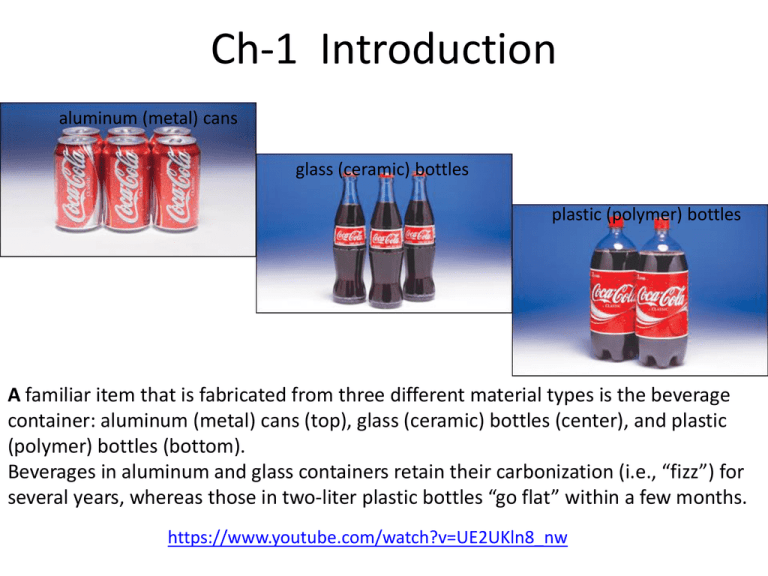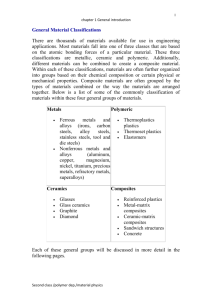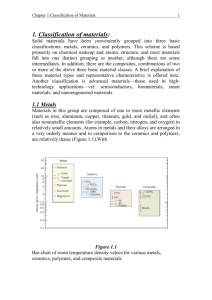Introduction to Materials Science - Chemistry at Winthrop University
advertisement

Ch-1 Introduction aluminum (metal) cans glass (ceramic) bottles plastic (polymer) bottles A familiar item that is fabricated from three different material types is the beverage container: aluminum (metal) cans (top), glass (ceramic) bottles (center), and plastic (polymer) bottles (bottom). Beverages in aluminum and glass containers retain their carbonization (i.e., “fizz”) for several years, whereas those in two-liter plastic bottles “go flat” within a few months. https://www.youtube.com/watch?v=UE2UKln8_nw 1.1 Historical Perspective Our everyday life is influenced by materials: Transportation, housing, clothing, communication, recreation, and food production. Historically, the development and advancement of societies have been intimately tied to the members' ability to produce and manipulate materials to fill their needs. In fact, early civilizations have been designated by the level of their materials development (Stone Age: 2.5 million BC, Bronze Age: 3500 BC, Iron Age: 1000 BC). Earliest humans: stone, wood, clay, skins, etc. pottery and various metals Discovery that the material property could be altered by heat treatments and by the addition of other substances. Metals, plastics, glasses, fibers, and semiconducting materials. 1.2 Materials Science and Engineering Structure of a material usually relates to the arrangement of its internal components. Subatomic structure: electrons within an atom and interactions with nuclei. Atomic structure encompasses the organization of atoms or molecules. Microscopic structure contains large groups of atoms that are normally agglomerated together, which can be observed using some type of microscope. Macroscopic structures can be viewed with the naked eye. Virtually all important properties of solid materials may be grouped into six different categories: mechanical, electrical, thermal, magnetic, optical, and deteriorative. Four components of the discipline of materials science and engineering: Three thin disk specimens of aluminum oxide: transparent, translucent, & opaque. These differences in optical properties (Ch-21) are a consequence of differences in structure of these materials, which have resulted from the way the materials were processed. 1.4 Classification of Materials Solid materials have been conveniently grouped into three basic categories: metals, ceramics, and polymers. This scheme is based primarily on chemical makeup and atomic structure. metals and metal alloys ceramic materials polymeric materials Composites are engineered combinations of two or more different materials. The design goal of a composite is to achieve a combination of properties that is not displayed by any single material, and also to incorporate the best characteristics of each of the component materials. GFRP (Glass fiber reinforced polymer), Fiberglass: glass fibers embedded within a polymer. CFRP (carbon fiber reinforced polymer), used in aerospace and high-tech sporting, Ch-16. Metals Metals are relatively stiff and strong, yet are ductile, and are resistant to fracture, which accounts for their widespread use in structural applications. Ch-6 & Ch-11. Metallic materials have free-electrons, and many properties of metals are directly attributable to these electrons. For example, metals are extremely good conductors of electricity and heat, and are not transparent to visible light; a polished metal surface has a lustrous appearance. In addition, some of the metals (i.e., Fe, Co, and Ni) have desirable magnetic properties. Ch-20. Ceramics (Chap-12 & 13) Ceramics are compounds between metallic and nonmetallic elements; they are most frequently oxides, nitrides, and carbides. For example, common ceramic materials include aluminum oxide (or alumina, Al2O3), silicon dioxide (or silica, SiO2), silicon carbide (SiC), silicon nitride (Si3N4), and, in addition, what some refer to as the traditional ceramics—those composed of clay minerals (i.e., porcelain), as well as cement and glass. Furthermore, ceramic materials are typically insulative to the passage of heat and electricity (i.e., have low electrical conductivities, Figure 1.7), and are more resistant to high temperatures and harsh environments than metals and polymers. With regard to optical characteristics, ceramics may be transparent, translucent, or opaque; and some of the oxide ceramics (e.g., Fe3O4) exhibit magnetic behavior (Ch-20). mechanical behavior Ceramic materials are relatively stiff and strong, comparable those of the metals (Figures 1.4 and 1.5). In addition, they are typically very hard. Historically, ceramics have exhibited extreme brittleness (lack of ductility) and are highly susceptible to fracture (Figure 1.6). However, newer ceramics are being engineered to have improved resistance to fracture; these materials are used for cookware, cutlery, and even automobile engine parts. Strength & Resistance to Fracture Polymers: Chap 14 & 15 Polymers (plastic and rubber) are organic compounds that are chemically based on carbon, hydrogen, and other nonmetallic elements (i.e., O, N, and Si). They have very large molecular structures, often chainlike in nature, that often have a backbone of carbon atoms. Some of the common and familiar polymers are polyethylene (PE), nylon, poly(vinyl chloride) (PVC), polycarbonate (PC), polystyrene (PS), and silicone rubber. These materials typically have low densities (Figure 1.3), whereas their mechanical characteristics are generally dissimilar to the metallic and ceramic materials—they are not as stiff nor as strong as these other material types (Figures 1.4 and 1.5). However, on the basis of their low densities, many times their stiffnesses and strengths on a per-mass basis are comparable to the metals and ceramics. Polymers are extremely ductile and pliable (i.e., plastic), which means they are easily formed into complex shapes. They are relatively inert chemically and unreactive in a large number of environments. One major drawback to the polymers is their tendency to soften and/or decompose at modest temperatures, which, in some instances, limits their use. They have low electrical conductivities (Figure 1.7) and are nonmagnetic. 1.5 Advanced Materials Semiconductors, Biomaterials, Smart Materials, and nano-Engineered Materials Used in high-technology applications. By high technology we mean a device or product that operates or functions using relatively intricate and sophisticated principles; Examples include electronic equipment (camcorders, CD/DVD players, etc.), computers, fiber-optic systems, spacecraft, aircraft, and military rocketry. These advanced materials are typically traditional materials whose properties have been enhanced, and also newly developed, high-performance materials. They may be of all material types (e.g., metals, ceramics, polymers), and are normally expensive. Advanced materials include semiconductors, biomaterials, and what we may term “materials of the future” (smart materials and nano-engineered materials). These materials are used for lasers, integrated circuits, magnetic information storage, liquid crystal displays (LCDs), and fiber optics. Semiconductors Semiconductors have electrical properties that are intermediate between the electrical conductors (i.e., metals and metal alloys) and insulators (i.e., ceramics and polymers)— see Figure 1.7. The electrical characteristics of these materials are extremely sensitive to the presence of minute concentrations of impurity atoms, for which the concentrations may be controlled over very small spatial regions. Semiconductors have made possible the advent of integrated circuitry that has totally revolutionized the electronics and computer industries (not to mention our lives) over the past three decades. Biomaterials Biomaterials are employed in components implanted into the human body for replacement of diseased or damaged body parts. These materials must not produce toxic substances and must be compatible with body tissues (i.e., must not cause adverse biological reactions). Ex: Filling for tooth cavities, breast implants, artificial hip, and pacemakers. All of the preceding materials—metals, ceramics, polymers, composites, and semiconductors— may be used as biomaterials. http://www.healthcentral.com/heart-disease/h/pacemaker-side-effects.html Smart Materials Smart (or intelligent) materials are a group of new and state-of-the-art materials now being developed that will have a significant influence on many of our technologies. These materials are able to sense changes in their environment and then respond to these changes in predetermined manners—traits that are also found in living organisms. Components of a smart material (or system) include some type of sensor (that detects an input signal), and an actuator (that performs a responsive and adaptive function). Actuators may be called upon to change shape, position, natural frequency, or mechanical characteristics in response to changes in temperature, electric fields, and/or magnetic fields. Commonly used for actuators (4): shape-memory alloys, piezoelectric ceramics, magnetostrictive materials, and electrorheological/magnetorheological fluids. Shape-memory alloys are metals that, after having been deformed, revert back to their original shape when temperature is changed (10.9). Piezoelectric ceramics expand and contract in response to an applied electric field (or voltage); conversely, they also generate an electric field when their dimensions are altered (18.25). Magnetostrictive materials is analogous to that of the piezoelectrics, except that they are responsive to magnetic fields. Electrorheological and magnetorheological fluids are liquids that experience dramatic changes in viscosity upon the application of electric and magnetic fields, respectively. Nanoengineered Materials These are not distinguished on the basis of their chemistry, but rather, size; the nano-prefix denotes that the dimensions of these structural entities are on the order of a nanometer (10-9 m)—as a rule, less than 100 nanometers (equivalent to approximately 500 atom diameters). Nanotechnology uses scanning probe microscopes (Section 4.10), which permit observation of individual atoms and molecules, and the ability to carefully arrange atoms (i.e., “materials by design”). This provides opportunities to develop mechanical, electrical, magnetic, and other properties that are not otherwise possible. Nanomaterials are finding niches in electronic, biomedical, sporting, energy production, and other industrial applications: •Catalytic converters for automobiles—Chapter 4 •Carbon nanotubes—Chapter 12 •Particles of carbon black as reinforcement for automobile tires—Section 16.2 •Nanocomposites in tennis balls—Chapter 16 •Magnetic nanosize grains that are used for hard disk drives—Section 20.11 •Magnetic particles that store data on magnetic tapes—Section 20.11 The safety of nanomaterials is unexplored, there are concerns that they may be absorbed into the human body, and if present in sufficient concentrations may pose health risks.











